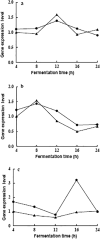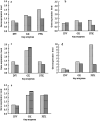Effects of carbon concentration, oxygen, and controlled pH on the engineering strain Lactiplantibacillus casei E1 in the production of bioethanol from sugarcane molasses
- PMID: 34176008
- PMCID: PMC8236424
- DOI: 10.1186/s13568-021-01257-x
Effects of carbon concentration, oxygen, and controlled pH on the engineering strain Lactiplantibacillus casei E1 in the production of bioethanol from sugarcane molasses
Abstract
Sugarcane molasses are considered a potential source for bioethanol's commercial production because of its availability and low market price. It contains high concentrations of fermentable sugars that can be directly metabolized by microbial fermentation. Heterofermentative lactic acid bacteria, especially Lactiplantibacillus casei, have a high potential to be a biocatalyst in ethanol production that they are characterized by strong abilities of carbohydrate metabolism, ethanol synthesis, and high alcohol tolerance. This study aimed to evaluate the feasibility of producing ethanol by Lactiplantibacillus casei used the ethanologen engineering strain L. casei E1 as a starter culture and cane molasses as substrate medium. The effects of environmental factors on the metabolism of L. casei E1 were analyzed by high-performance liquid chromatography (HPLC) system, and the gene expression of key enzymes in carbon source metabolism was detected using quantitative real-time PCR (RT-qPCR). Results showed that the strain could grow well, ferment sugar quickly in cane molasses. By fermenting this bacterium anaerobically at 37 °C for 36 h incubation in 5 °BX molasses when the fermenter's pH was controlled at 6.0, ethanol yield reached 13.77 g/L, and carbohydrate utilization percentage was 78.60%. RT-qPCR results verified the strain preferentially ferment glucose and fructose of molasses to ethanol at the molecular level. In addition, the metabolism of sugars, especially fructose, would be inhibited by elevating acidity. Our findings support the theoretical basis for exploring Lactic acid bacteria as a starter culture for converting sugarcane molasses into ethanol.
Keywords: Bioethanol; Fermentation; Lactiplantibacillus casei; Sugarcane molasses.
Conflict of interest statement
The authors declare that they have no conflict of interest.
Figures


 , Glucose
, Glucose  , Fructose
, Fructose  . a 5 °BX; b 7.5 °BX; c 10 °BX; d 20 °BX
. a 5 °BX; b 7.5 °BX; c 10 °BX; d 20 °BX
 , Acetate
, Acetate  , Ethanol
, Ethanol  . a 5 °BX; b 7.5 °BX; c 10 °BX; d 20 °BX
. a 5 °BX; b 7.5 °BX; c 10 °BX; d 20 °BX
 , Acetate
, Acetate  , Ethanol
, Ethanol 

 and non-pH control
and non-pH control  on the growth of strain. pH changes
on the growth of strain. pH changes  under non-pH control
under non-pH control
 , Glucose
, Glucose  , Fructose
, Fructose 

 and non-pH control
and non-pH control  on key enzyme gene expression of carbon source metabolism. a GK, glucokinase; b INV, invertase; c PFK, phosphofructokinase
on key enzyme gene expression of carbon source metabolism. a GK, glucokinase; b INV, invertase; c PFK, phosphofructokinase
 and non-pH control
and non-pH control  . INV, invertase; GK, glucokinase; PFK, phosphofructokinase. a 4 h; b 8 h; c 12 h; d 16 h; e 24 h
. INV, invertase; GK, glucokinase; PFK, phosphofructokinase. a 4 h; b 8 h; c 12 h; d 16 h; e 24 hSimilar articles
-
Synthetic redesign of Escherichia coli W for faster metabolism of sugarcane molasses.Microb Cell Fact. 2024 Sep 9;23(1):242. doi: 10.1186/s12934-024-02520-z. Microb Cell Fact. 2024. PMID: 39252026 Free PMC article.
-
Use of sugarcane molasses "B" as an alternative for ethanol production with wild-type yeast Saccharomyces cerevisiae ITV-01 at high sugar concentrations.Bioprocess Biosyst Eng. 2012 May;35(4):605-14. doi: 10.1007/s00449-011-0633-9. Epub 2011 Oct 5. Bioprocess Biosyst Eng. 2012. PMID: 21971607
-
Integrating sugarcane molasses into sequential cellulosic biofuel production based on SSF process of high solid loading.Biotechnol Biofuels. 2018 Dec 18;11:329. doi: 10.1186/s13068-018-1328-0. eCollection 2018. Biotechnol Biofuels. 2018. PMID: 30568729 Free PMC article.
-
Study of sugarcane pieces as yeast supports for ethanol production from sugarcane juice and molasses.J Ind Microbiol Biotechnol. 2008 Dec;35(12):1605-13. doi: 10.1007/s10295-008-0404-z. Epub 2008 Aug 7. J Ind Microbiol Biotechnol. 2008. PMID: 18685877
-
Recent trends in bioethanol production from food processing byproducts.J Ind Microbiol Biotechnol. 2016 Nov;43(11):1593-1609. doi: 10.1007/s10295-016-1821-z. Epub 2016 Aug 26. J Ind Microbiol Biotechnol. 2016. PMID: 27565674 Review.
Cited by
-
Optimization of erythritol production through fermentation using molasses as carbon source.Acta Biochim Pol. 2025 Jan 8;71:14000. doi: 10.3389/abp.2024.14000. eCollection 2024. Acta Biochim Pol. 2025. PMID: 39845101 Free PMC article.
-
Enhanced Poly-γ-Glutamic Acid Production by a Newly Isolated Bacillus halotolerans F29.J Microbiol. 2024 Aug;62(8):695-707. doi: 10.1007/s12275-024-00153-w. Epub 2024 Aug 20. J Microbiol. 2024. PMID: 39164498
-
Biomimetic Construction of Artificial Selenoenzymes.Biomimetics (Basel). 2023 Jan 28;8(1):54. doi: 10.3390/biomimetics8010054. Biomimetics (Basel). 2023. PMID: 36810385 Free PMC article. Review.
References
-
- Agbogbo KF, Coward-Kelly G, Torry-Smith M, Wenger KS. Fermentation of glucose/xylose mixtures using Pichia stipitis. Process Biochem. 2006;41:2333–2336. doi: 10.1016/j.procbio.2006.05.004. - DOI
-
- Baki AS, Bande YM, Bello A. Comparative Studies on Bioethanol Production from Cassava Peels using Saccromyces Cerevisae and Zymomonas Mobilis. Open Access J Biomed Eng Biosci. 2020;3:373–378. doi: 10.32474/OAJBEB.2020.03.000174. - DOI
-
- Britz TJ, Tracey RP. The combination effect of pH, SO2, ethanol and temperature on the growth of Leuconostoc oenos. J Bacteriol. 1990;68:23–31. doi: 10.1111/j.1365-2672.1990.tb02544.x. - DOI
Grants and funding
LinkOut - more resources
Full Text Sources

